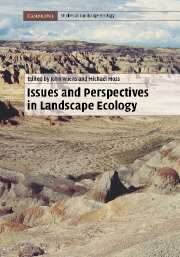Book contents
- Frontmatter
- Contents
- List of contributors
- Preface
- PART I Introductory perspectives
- PART II Theory, experiments, and models in landscape ecology
- 3 Theory in landscape ecology
- 4 Hierarchy theory and the landscape … level? or, Words do matter
- 5 Equilibrium versus non-equilibrium landscapes
- 6 Disturbances and landscapes: the little things count
- 7 Scale and an organism-centric focus for studying interspecific interactions in landscapes
- 8 The role of experiments in landscape ecology
- 9 Spatial modeling in landscape ecology
- 10 The promise of landscape modeling: successes, failures, and evolution
- PART III Landscape patterns
- PART IV Landscape dynamics on multiple scales
- PART V Applications of landscape ecology
- PART VI Cultural perspectives and landscape planning
- PART VII Retrospect and prospect
- Index
- Plate section
- References
8 - The role of experiments in landscape ecology
from PART II - Theory, experiments, and models in landscape ecology
Published online by Cambridge University Press: 20 November 2009
- Frontmatter
- Contents
- List of contributors
- Preface
- PART I Introductory perspectives
- PART II Theory, experiments, and models in landscape ecology
- 3 Theory in landscape ecology
- 4 Hierarchy theory and the landscape … level? or, Words do matter
- 5 Equilibrium versus non-equilibrium landscapes
- 6 Disturbances and landscapes: the little things count
- 7 Scale and an organism-centric focus for studying interspecific interactions in landscapes
- 8 The role of experiments in landscape ecology
- 9 Spatial modeling in landscape ecology
- 10 The promise of landscape modeling: successes, failures, and evolution
- PART III Landscape patterns
- PART IV Landscape dynamics on multiple scales
- PART V Applications of landscape ecology
- PART VI Cultural perspectives and landscape planning
- PART VII Retrospect and prospect
- Index
- Plate section
- References
Summary
Why should landscape ecologists conduct experiments?
Experiments play a crucial role in science. They provide the most reliable and efficient means of establishing knowledge. Only proper experiments can establish cause–effect relations between processes and patterns as well as unambiguous links between abstract theory and material nature. Thus, experiments should be a part of scientific enquiries, whenever feasible and ethical.
Landscape ecology, however, is a scientific discipline relatively devoid of experiments. This well known, albeit undesirable, state of affairs is often said to stem from lack of practical feasibility to conduct landscape ecological experiments. True, landscape ecologists are frequently concerned with phenomena covering temporal and spatial scales that are too broad to facilitate an essential ingredient of proper experimental design; that is, replicates of treatment levels are randomized among a sample of experimental units. Clearly, if the extent of the experimental units encompasses region-wide landscapes and the treatments constitute levels of landscape variables such as composition and connectivity, proper experiments may not be feasible. So-called “quasi-experiments” or “natural experiments,” which denote single large-scale accidental or intentional perturbations at the landscape level, or “mensurative experiments,” referring to any kind of comparison with respect to a focal environmental variable (Hulbert, 1984; McGarigal and Cushman, 2002), provide unique opportunities for informative observations in landscape ecology. However, such approaches do not necessarily give rise to unbiased estimation of effect sizes and confidence intervals. This can only be reliably obtained through proper experiments.
- Type
- Chapter
- Information
- Issues and Perspectives in Landscape Ecology , pp. 70 - 78Publisher: Cambridge University PressPrint publication year: 2005
References
- 9
- Cited by



